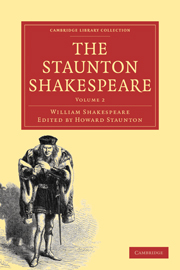Book contents
- Frontmatter
- Contents
- ALL'S WELL THAT ENDS WELL
- KING HENRY THE FIFTH
- AS YOU LIKE IT
- PERICLES, PRINCE OF TYRE
- TWELFTH NIGHT; OR, WHAT YOU WILL
- THE FIRST PART OF KING HENRY THE SIXTH
- THE SECOND PART OF KING HENRY THE SIXTH
- THE THIRD PART OF KING HENRY THE SIXTH
- TIMON OF ATHENS
- KING RICHARD THE THIRD
- MEASURE FOR MEASURE
- KING HENRY THE EIGHTH
- CYMBELINE
KING HENRY THE FIFTH
Published online by Cambridge University Press: 29 August 2010
- Frontmatter
- Contents
- ALL'S WELL THAT ENDS WELL
- KING HENRY THE FIFTH
- AS YOU LIKE IT
- PERICLES, PRINCE OF TYRE
- TWELFTH NIGHT; OR, WHAT YOU WILL
- THE FIRST PART OF KING HENRY THE SIXTH
- THE SECOND PART OF KING HENRY THE SIXTH
- THE THIRD PART OF KING HENRY THE SIXTH
- TIMON OF ATHENS
- KING RICHARD THE THIRD
- MEASURE FOR MEASURE
- KING HENRY THE EIGHTH
- CYMBELINE
Summary
The earliest edition of this play was published in 1600, under the title of—'. The Chronicle History of Henry the fift, With his battell fought at Agin Court in France. Togither with Auntient Pistoll. As it hath bene sundry times playd by the Right honorable the Lord Chamberlaine his seruants. London,—Printed by Thomas Crcede, for Tho. Millington and Iohn Busby.” This was followed by another edition in 1602, and a third, in 1608.
The question whether the copy from which these quartos were printed was a maimed and surreptitious version of the perfect play, made up from what could be collected by short-hand, or remembered from the stage representation, as Mr. Collier believes, or whether it was an authentic transcript of the poet's first draft of the piece, but corrupted by the ordinary printing-house blunders, involves so much that is important in connexion with Shakespeare's method of production, that it will be best considered when we come to his Life.
Upon the evidence of a passage in the Chorus to the Fifth Act,—
“Were now the general of our gracious empress
(As, in good time, he may,) from Ireland coming,
Bringing rebellion broached on his sword,
How many would the peaceful city quit,
To welcome him!”—
which bears an unmistakeable reference to the Irish expedition of the Earl of Essex, begun and terminated in 1599, this play is supposed to have been written in that year.
- Type
- Chapter
- Information
- The Staunton Shakespeare , pp. 59 - 122Publisher: Cambridge University PressPrint publication year: 2009First published in: 1859

